by Sam McGowan
Thanks to the rather far-fetched mid-1970s TV series Black Sheep Squadron, the bent-wing image of the Chance-Vought F4U Corsair is no doubt one of the most vivid of the World War II fighters in the minds of most Americans. The dark blue forms of the squadron’s Corsairs came on the screen every week, thrilling millions who watched the fictionalized exploits of the men of VMF-214, the United States Marine Corps fighter squadron commanded by the legendary Major Gregory “Pappy” Boyington, as they battled sinister Japanese aces in the skies over the Solomon Islands in 1943.
The events depicted in the series were contrived, but the airplanes were real, and the series was based on real men who had flown the same type of fighter against the Japanese several decades earlier when the bent-wing Corsair symbolized Marine Corps Aviation. (Get more in-depth looks at the history of military aviation inside Military Heritage magazine.)
Development on the F4U Corsair
The Corsair was the first of several successful fighter designs built around Pratt & Whitney’s R-2800 Double Wasp engine, so called because of the double bank of nine cylinders that was designed to increase the power of the company’s famous Wasp engine. United Aircraft’s Vought division submitted the design in competition for a new fighter requirement put forth by the U.S. Navy in early 1938 for a high-performance carrier-borne fighter that would be capable of achieving and maintaining air superiority above the fleet.
To make the most efficient use of the powerful engine, Vought’s design team chose an especially large propeller, a choice that extended the length of the fuselage by several feet so the ends of the propeller blades would not reach the ground and also led to the airplane’s unique wings. The elongated nose severely restricted visibility, particularly when the airplane was on the ground, making the Corsair difficult to taxi. It also limited forward visibility during the critical approach to landing, as the end of the runway would completely disappear from the pilot’s view when the airplane was on short final. Unfortunately, the lack of forward visibility reduced the Corsair’s capabilities as a carrier airplane, although this would turn out to be a bonus for the Marines in the early days of the war when high-performance aircraft were at a premium.
The size of the prop also led to the most prominent of the Corsair features. Instead of using longer landing gear that would be difficult to stow in the wing of an airplane designed to operate off aircraft carriers, the designers decided instead to bend the wings into a gull shape so the landing-gear section of the wing would be closer to the ground than the fuselage. The bent wings allowed the use of shorter struts while keeping the propeller blades clear of the ground and gave the fighter the gull-wing appearance that distinguished Corsairs from other fighters of World War II. Only the Stuka dive-bomber used by Germany’s Luftwaffe in Europe was characterized by a similarly shaped wing.
A Top Speed of Over 400 mph
By the spring of 1940, the prototype Corsair was ready to fly, and on May 29 it took to the skies for the first time from the Vought factory at Bridgeport, Connecticut. There is confusion over the actual date of the first flight. Some sources say it was on April 29, and others set the date a month later on May 29, which is probably the correct date. The design was not without faults, and test flights often ended prematurely due to mechanical problems.
The fifth flight ended in disaster when the airplane ran out of fuel and had to be crashlanded on a golf course. Although the airframe was salvageable, the prototype suffered major damage in the crash, which caused a setback in the test program. By October, it was back in the air, and on the first day of the month the airplane made a short flight from the Vought factory at Bridgeport to Hartford and was clocked at an average ground speed of 405 miles per hour.
Modern aviation media experts claim this as the first time a fighter had flown faster than 400 miles per hour in level flight, but that’s really not true. The reported 400 miles per hour was actually ground speed, which is the actual speed of an airplane over the ground, a combination of true airspeed and a correction for a headwind or tailwind. In this instance, the Corsair’s speed was boosted by a considerable tailwind. Lockheed’s prototype XP-38 had exceeded 400 miles per hour during a cross-country flight more than a year previously. Republic’s P-47, which was still under development with the same engine, would be considerably faster. The official top speed for the first production F4Us was only 405 mph, although later models were capable of speeds in excess of 450 mph.
Marines Adopt the F4U
Design problems hampered the new fighter’s production, and it was not until June 1942 that the first production airplane rolled off the assembly line at Stratton. The Navy took delivery of its first F4U a month later. It did not take long for Navy test pilots to realize they had a problem on their hands. The Corsair was difficult to handle, and some wags later referred to it as The Ensign Eliminator due to the requirement for an experienced pilot to be able to handle it in the edges of the realm of flight.
Visibility problems caused by the long nose were the most serious. As a result, the F4U Corsair failed to pass carrier trials, and it was two years before the Navy approved it for shipboard operations. Meanwhile, Marine Corps fighter squadrons had gone into combat in the Southwest Pacific with obsolete Grumman F4F Wildcats and needed something capable of intercepting Japanese bombers at high altitude. Since the Navy rejected the F4U as a fleet fighter, the Navy Department decided to give the Corsair to the Marines and adopt the Grumman F6F Hellcat as the Navy’s primary fighter.
Both the Navy and Marine Corps were hurting for a decent fighter in 1942, but due to heavy carrier losses at the battles of Coral Sea and Midway, naval aviation was temporarily out of the war and could wait until new carriers could be launched and made ready for sea to equip its squadrons. The Grumman F6F Hellcat, which used the same engine as the Corsair, was under development, and deliveries were projected to start soon so the Navy adopted it as its primary fleet fighter.
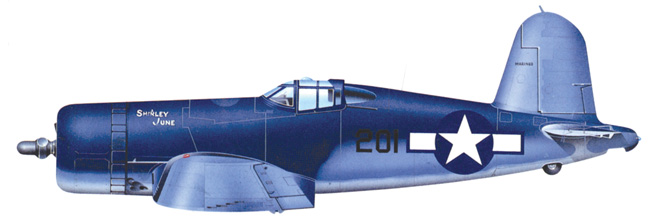
The Marines, on the other hand, had been sent to the South and Southwest Pacific where Pacific Ocean area of operations forces were battling the Japanese on Guadalcanal. The Corps’ F4F Wildcats lacked the performance to intercept the Japanese bombers that came over regularly to blast Henderson Field, although superior Marine pilots were able to more than hold their own against the Japanese bombers and fighters when they were able to gain altitude before the enemy aircraft reached their targets or when they came down to lower altitudes where they were more evenly matched.
Army P-39s and P-40s were also based at Henderson as part of the “Cactus Air Force,” and while in some regards they were superior to the Wildcat, which required the pilot to hand-crank the landing gear after takeoff, they were still incapable of gaining altitude in time to intercept a bomber formation. The Corsair’s performance held a lot of promise, although by the time it entered combat the battle of Guadalcanal had been decided. Consequently, Marine F4Us would see service primarily in the escort and ground-attack role rather than as interceptors.
First Combat For the F4U Corsair
VMF-124 was the first Marine squadron to receive F4U Corsairs, and by the end of 1942 the squadron had become operational. They were immediately deployed to Guadalcanal, arriving on the night of February 11-12. The following morning the squadron went out on a rescue mission. Before the day was out, squadron airplanes had logged nine hours in the air. On February 13, a flight of 12 Corsairs from VMF-124 escorted Thirteenth Air Force B-24 bombers to Bougainville, the longest escort mission of the war in the Solomons at the time.
The Corsair’s first exposure to air-to-air combat occurred the following day, when VMF-124 contributed several airplanes for a joint-service force made up of Army P-38s and P-40s, Navy Liberators, and the Marine F4Us. Eight American fighters and two bombers were lost, including a pair of Corsairs, one of which collided with one of the three Japanese Zekes that went down in the battle. It was an inauspicious start for the Corsair.
The February 14 losses led to a temporary cancellation of further daylight raids against Japanese positions, and the combined force of Army and Navy Liberators turned to night attack until fighter strength could be built up. Daylight missions did not resume until March 28 when eight VMF-124 Corsairs were part of a strike force against the Shetlands. The Marines missed out as seven Corsairs turned back, along with three of the eight P-38s. The rest of the force tangled with a formation of Japanese Nakijima floatplane fighters and shot down eight of them.
Ken Walsh: First Corsair Ace
Four days later, Corsair pilots began making their mark. A flight of Corsairs had just been relieved on combat air patrol over the Russell Islands by a flight of P-38s when the Army formation was attacked by a large number of Japanese fighters. The Marines returned to the battle, and the combined force accounted for 20 Japanese aircraft. Three were credited to 2nd Lieutenant Ken Walsh of VMF-124, who would become the first Corsair ace and would later be decorated with the Medal of Honor. Walsh was a former enlisted pilot who had only recently been commissioned, but he had been flying observation planes, scout bombers, and fighters in the Marine Corps since 1938 and was probably one of the most experienced pilots in the squadron.
Walsh and the rest of VMF-124 missed out on another huge air battle on April 7 because the squadron had left for rest and recuperation in Australia three days before when VMF-213 arrived at Henderson Field. When radar picked up a large force of Japanese planes headed for the Russells, 76 fighters, including Army P-38s and P-39s and Marine F4Fs and F4Us, were sent up to meet them. Army pilots were credited with 13 of the 39 Japanese airplanes that went down that day—Marine and Navy fighters got the rest.
By May, VMF-124 was back in action, and on the 13th Ken Walsh became the first Corsair ace when he shot down three Zekes, bringing his total to six. Such victories as Walsh’s over the three Zeros proved that the previously feared Zero was no longer superior to U.S. naval fighters. By the middle of August, Walsh had shot down 10 Japanese planes and was now a double ace. On August 15, Walsh shot down three more Japanese planes before his Corsair was shot up by another in an action when the Marines were badly outnumbered. Walsh repeatedly dived into the Japanese formation before his airplane was knocked out of action. VMF-124 pilots claimed 10 victories that day.
On August 30, Walsh performed another heroic action that, combined with the events of August 15, would result in the Medal of Honor. He was part of a mission escorting Navy Liberators against Kahili airfield on Bougainville when his airplane developed engine trouble and he was forced to land at Vella Lavella, where he jumped into another Corsair and took off to catch up with the formation. A force of about 50 Zekes attacked the Liberators, and Walsh went after them. He shot down four before his own Corsair was shot down and he went into the sea. He was rescued and soon went back home to receive the Medal of Honor. He would return to the Pacific for another combat tour in Corsairs with VMF-222 in the Philippines and would finish the war with 21 confirmed kills, the last one being a kamikaze he shot down during the Battle of Okinawa.
The Swashbucklers
The most famous of the F4U Corsair squadrons, thanks largely to the fame of one of its commanders, was VMF-214. The squadron entered combat a few days after VMF-124 but was equipped with F4F Wildcats during its first tour. After rest and reequipping with Corsairs, VMF-214 returned to combat in June 1943. On August 6 the squadron, then known as The Swashbucklers, produced its first ace when former enlisted pilot Al Jensen shot down a Japanese Jake fighter and two Zekes to add to the two victories he had scored when he was flying Wildcats.
On August 28, Jensen earned the Navy Cross when he attacked the Japanese airfield at Kahili. He was officially credited with 15 aircraft destroyed on the ground, but aerial photographs taken the next day showed 24 destroyed airplanes on the field. In early September, squadron personnel went to Australia in preparation for returning to the States, and when they left the squadron was broken up and the designation was given to a new unit that was being formed locally.
Major Gregory Boyington and the Black Sheep
Author and Hollywood producer Stephen J. Cannell depicted the men of VMF-214 as a drunken bunch of misfits in his 1970s television series Black Sheep Squadron, a depiction that did not set well with the aging veterans who had actually made up the unit. While the description did perhaps fit their commander, Major Gregory Boyington, who had a reputation as a hell-raiser and malcontent who could not get along with his superiors, the squadron was actually made up of pilots with varying backgrounds who were scattered around the South Pacific in nonflying positions or who had arrived in the theater as replacements but had not been assigned to combat units.
Boyington was a prewar Marine Corps pilot who had left the service to fight in China with the American Volunteer Group, apparently to earn money to pay off his huge pile of debts. Although he was credited with six Japanese planes, including 3.75 on the ground, he got into trouble with General Claire Chennault and went AWOL from the group, an act for which he was given a dishonorable discharge. Ordinarily this would probably have ended his military aviation career, but experienced combat pilots were few in mid-1942, and after he got back to the States the Marines took him back and gave him the rank of major.
Boyington went to Guadalcanal in early 1943, and after a stint as a staff officer, took command of VMF-122, which was still equipped with Wildcats. He was constantly butting heads with a superior officer with whom he had a prewar history, and by mid-September he was in an administrative position matching up newly arrived replacement pilots with combat squadrons.
There was a shortage of combat units in the Solomons, and someone, allegedly Boyington, suggested forming a new squadron made up of pilots who were already in the theater but were not assigned to combat units. According to Boyington’s memoir, he was on desk duty in charge of assigning replacement pilots to squadrons and suggested that he be allowed to form a squadron of his own. Perhaps to get him out of their hair, the staff of Marine Air Wing One apparently went along with the plan, and Boyington was placed in command of a new VMF-214.
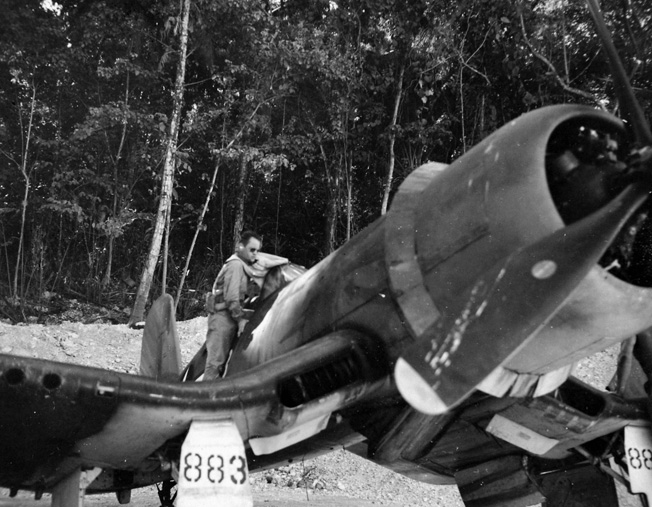
Twenty-six pilots were pulled together, including eight who had been in VMF 122 with Boyington, a couple who had flown with other Corsair squadrons, three who had flown with the Royal Canadian Air Force, four who had instructed in Corsairs in the States, and several who had been flying Wildcats. All in all, the men of the soon to be famous squadron were a pretty experienced bunch. The original VMF-214 pilots were sent back to the United States, and the new unit decided to forgo the old name Swashbucklers in favor of a new one that they felt better reflected their former status as pilots with no family connection—Black Sheep.
The Black Sheep moved to their combat base in the Russell Islands in September and flew their first combat mission on the 14th. Over the next few months, they racked up one of the most impressive combat records of any military aviation unit in history. In 84 days of combat, the men of VMF-214 were credited with over 200 Japanese planes destroyed or damaged in the air and on the ground, as well as dozens of barges and other ground targets. Almost 100 of their kills—94 confirmed—were air-to-air.
Their commander, Major Boyington, led the pack. By the time he was shot down over Rabaul on January 3, 1944, he had been credited with 22 victories. His AVG victories brought his total to 28. Boyington was captured and spent the rest of the war as a POW. After the war, he was awarded the Medal of Honor. Not long after the loss of their commander, VMF-214 was again broken up after being awarded a Presidential Unit Citation. The designation would reemerge later in the war as a Corsair squadron flying off the carrier USS Franklin.
Charles Lindberg Joins the F4U Corsair Program
It was the F4U Corsair that led to famed aviator Charles Lindbergh’s combat role in World War II. Blackballed by the White House and U.S. Army Air Forces commander General Henry H. Arnold because of his outspoken opposition to U.S. involvement in the war in Europe and the prewar resignation of his commission as a colonel in the Army Air Corps, Lindbergh sought a position in the aviation industry. In early 1942 United Aircraft President Eugene Wilson, a friend of Lindbergh’s, offered him a position with the company, but the offer was withdrawn due to pressure from the White House.
Lindbergh instead went to work for Henry Ford, who had no fear of the Roosevelt Administration and whose huge company was badly needed to produce war materials, including Consolidated Aircraft Company’s B-24 Liberator, Republic’s P-47 Thunderbolt fighter, and Pratt & Whitney’s family of engines. After Lindbergh became involved in high-altitude research work in fighters, Wilson reconsidered his relationship with the White House and asked Lindbergh to come to work for him in the Corsair program. At first, Lindbergh went back and forth between the two companies, but by the spring of 1944 he was working solely for United in research and development. As an experienced military pilot, he flew Corsairs on maneuvers with Marine units and on one occasion engaged two of the Corps’ best fighter pilots in a mock dogfight and beat them both. He was a man who knew the Corsair, and the leaders of Marine Aviation knew it.
Lindbergh’s involvement with the Corsair placed him in contact with many members of the military, and in the spring of 1944 he attended a meeting with Marine Corps representatives in Washington, D.C. During the course of the meeting, Lindbergh mentioned that United was getting conflicting reports on the capabilities of single- and twin-engine fighters, and he thought it would be a good idea for someone with considerable Corsair experience to visit Marine units in the Pacific and observe combat operations firsthand.
Marine Brig. Gen. Louis Wood said, “Why don’t you go?” Lindbergh replied that his relationship with the White House was not very good. Wood said that the White House did not need to know and that he would make the necessary arrangements for the trip.
Lindberg in Combat With the F4U
In April 1944, Lindbergh left for the South Pacific as a Corsair technical representative with authorization to fly missions as an observer. The first leg of the journey was a cross-country flight to deliver a Corsair to the Marine airfield at El Toro, California. He remained in California for a few days, visiting Marine fighter squadrons and talking to the pilots. His next stop was Hawaii, where he took time to visit bases and meet with fighter pilots, including a visit to Midway atoll before continuing to the South Pacific. He visited with Marine squadrons out of Espiritu Santo and Guadalcanal, and he started flying combat missions out of Green Island on May 22.
At first, there was some reluctance by senior Marine officers to allow a civilian to fly combat missions, but when a few flights to test the water produced no repercussions, the Lone Eagle was turned loose in South Pacific skies. By June 10, he had flown 13 missions, including escort missions and strafing attacks on Japanese barges. Lindbergh left the Marines for a while to fly P-38s with the Army, but stopped off for a few more weeks with Marine squadrons at Kwajalein and Tarawa before he returned to the United States. He intended to spend a few days in Guam, but decided to stop in the Marshall Islands first.
During his second visit with the Marines, the veteran aviator taught Corsair pilots new techniques for dive-bombing and convinced them that the fighter could carry much larger bombs than they believed. He proved to the Marines that the Corsair could carry a 3,000-pound bomb load on September 3, 1944, when he dropped three 1,000-pound bombs on Wotje Atoll. On September 8, he dropped the first 2,000-pound bomb ever delivered by a Corsair in another attack on Wotje. Five days later, he upped the ante to 4,000 pounds when he took off with one 2,000-pound bomb and two 1,000-pounders to drop in another attack.
Lindbergh also taught the Marines how to conserve fuel by operating at lower rpms and higher manifold pressure, a technique that extended the combat range of the fighters by several hundred miles. He had taught the same technique to Army pilots, a technique that allowed fighter pilots to escort bombers much deeper into Japanese territory than they had ever gone.
The Royal Navy Proves the F4U’s Carrier-Borne Capabilities
While the Marines were making the reputation of the F4U Corsair, the airplane had been designed to operate off carriers and had originally been intended for operations with the fleet. But for more than a year the Navy restricted its Corsairs to operations from land bases with Marine squadrons.
It fell to the British to prove that the huge fighter could be operated from ships. The Royal Navy purchased Corsairs for fleet use, and it was Royal Navy pilots who finally came up with a method that allowed the long-nosed airplanes to land on carriers. Instead of lining up with the carrier deck while several thousand feet out in a normal landing procedure, the British pilots began flying a curving approach that allowed them to keep the landing signals officer in sight until the airplane was in the landing groove, and it was just a simple matter of cutting power and letting the airplane touch the deck and engage the wires. Since the fighters would be halted by arresting gear and towed or pushed off the flight deck, taxiing was unnecessary.
The Jolly Rogers
The U.S. Navy decided to adopt the method and began equipping some of its own fighter squadrons with Corsairs and, since the war in the Solomons was winding down, made plans to station several Marine squadrons aboard ship once the pilots had been carrier qualified.
The first U.S. Navy Corsair squadron to see combat was VF-17, the Jolly Rogers. VF 17 was organized in early 1943 for assignment to the carrier Bunker Hill, one of the first of the Essex-class “fast carriers,” but special considerations led to its combat role as a land-based unit.
The Corsair was not a popular airplane in the Navy, and a lot of pilots wanted nothing to do with it. VF-17 commander, Lt. Cmdr. John Blackburn, was no exception, but he decided the airplane had some redeeming factors. After flying it for a while he was convinced it was actually an excellent fighter. The squadron trained at Norfolk, Virginia, and on the Outer Banks of North Carolina; it then joined the carrier at Norfolk shortly after it was launched at Quincy, Massachusetts, in July 1943.
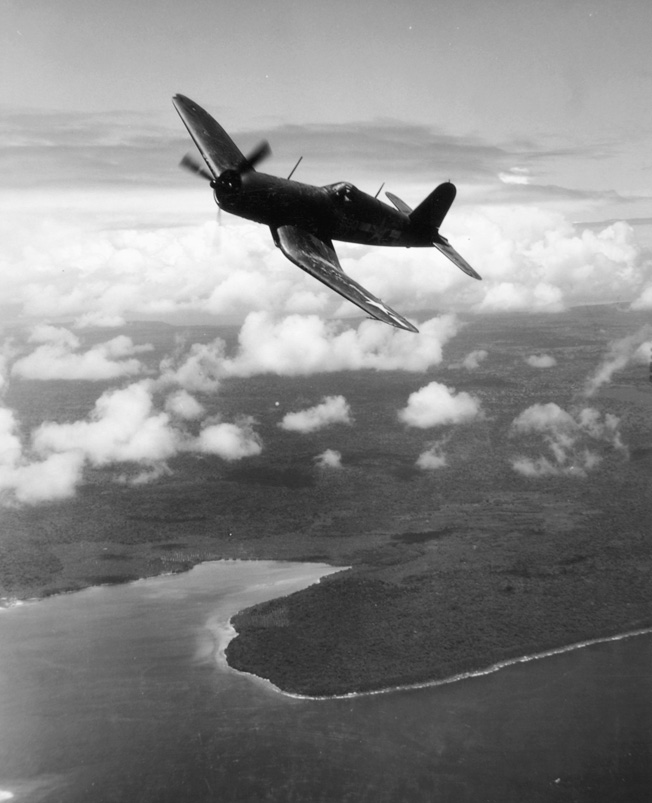
The Corsair’s problems were apparent to Blackburn and the pilots of his squadron, but he elected to turn down an offer to replace his F4Us with the new Grumman F6F Hellcat, which was just coming into the naval inventory. Bunker Hill set out for the Pacific in September by way of the Panama Canal and San Diego. The men of VF-17 were expecting to continue on to the Pacific for a combat tour, flying off the carrier, but the plan suddenly changed right after Bunker Hill departed San Diego. Blackburn was ordered to bring his airplanes and men back to San Diego. Instead of participating in the first sortie by the Essex-class ships, they were being sent to Espiritu Santo for land-based duty.
The men of VF-17 had proven that they could operate off a carrier with the F4U, but there was another issue. As the only operational Corsair squadron in the Navy, VF-17 would face some unique supply problems in fleet use. Maintaining the squadron’s airplanes would require special stores of aircraft parts, and replacement parts for a single squadron would be difficult to procure in a timely fashion through normal supply channels. To alleviate the problem, the Navy decided to use the squadron in the Solomons, where the Marines already had a number of squadrons flying F4Us and there were already adequate spare parts.
Neutralizing Rabaul
VF-17 arrived on Guadalcanal in late October, then proceeded north to its new base on New Georgia. Over the next several months, the men of VF-17 racked up an impressive record as 13 squadron members achieved ace status. On one mission in early November, members of the squadron landed back on Bunker Hill to refuel and rearm during the initial carrier attacks on Rabaul.
Operations around Rabaul were the focus of VF 17 missions. The Army’s Fifth Air Force had been operating against the Japanese stronghold for more than a year on mostly harassing missions, but with the Allied victory in the Solomons, the Americans were free to concentrate on the heavily defended target and allow Fifth Air Force to devote its attention to New Guinea. VF-17 fighters accounted for 60.5 Japanese airplanes in January alone, when the battle against Rabaul was at its height.
With bases closer to the target area, American aircraft were able to effectively neutralize the Japanese base while submarines, carrier aircraft, and land-based bombers prevented reinforcement and resupply. The war began moving north into the Central Pacific, and the Japanese forces defending Rabaul were bypassed after Japan decided to discontinue attempts to replace their aircraft losses. As things wound down around Rabaul, the intensity of combat decreased. In early March, VF-17 was relieved and the squadron deactivated.
Close Air Support at the Battle of Bloody Ridge
Throughout the Solomons campaign, Marine F4U squadrons and the lone squadron of Navy Corsairs were involved primarily as escort fighters and in attacks on Japanese shore installations and airfields, with frequent barge-hunting forays against Japanese coastal shipping. As Japanese air defenses lost their strength, Corsair squadrons were trained to begin operating in the close air support role, a mission that had developed during the battle for Guadalcanal using Marine F4Fs and Army P-39s.
The Marine Corps had become aware of the value of air attack in close support of troops in the 1920s when the Corps was involved in operations in Central America, but few steps had been taken to implement it as a Marine aviation mission. The concept of close air support became part of Marine doctrine in the 1930s, but little attention was paid to it in the planning for the invasion of Guadalcanal.
A handful of missions were flown by F4F pilots early in the campaign, but it was not until the Battle of Bloody Ridge that close air support proved decisive. Early on September 13, 1942, the Marines appealed to the commander of the 67th Fighter Squadron, an Army unit operating Bell P-400s, for a strafing mission at daybreak the next morning. Shortly after midnight, a large Japanese force launched an attack on what the Marines were calling Bloody Ridge, later referred to as Edson’s Ridge after the legendary commander of the 1st Raider Battalion.
At dawn, three P-400s took off and immediately attacked. Two were hit by ground fire, one during its first run and the other during its second, and had to return to Henderson Field, but the third pilot came around for a third pass and kept strafing until he ran out of ammunition. The effect on the Japanese was devastating. Hundreds were killed and wounded, and the survivors retreated into the jungle. Later that day, General Alexander A. Vandegrift, the commander of the Marines on the island, visited the three airmen and told them that their attack had decided the outcome of the battle of Guadalcanal.
After Guadalcanal, the Marine Corps began emphasizing close air support, but it would be nearly two years before the F4U became heavily involved. Planning for operations at Tarawa and the Central Pacific called for close air support by Navy and Marine squadrons flying Douglas SBD dive-bombers and F6F Hellcats. Even though they had not been assigned the close air support mission as yet, Marine Corsair squadrons began conducting dive-bombing missions, and after Lindbergh demonstrated that the Corsair could carry a 4,000-pound bomb load, the F4U became even more important as an attack weapon.
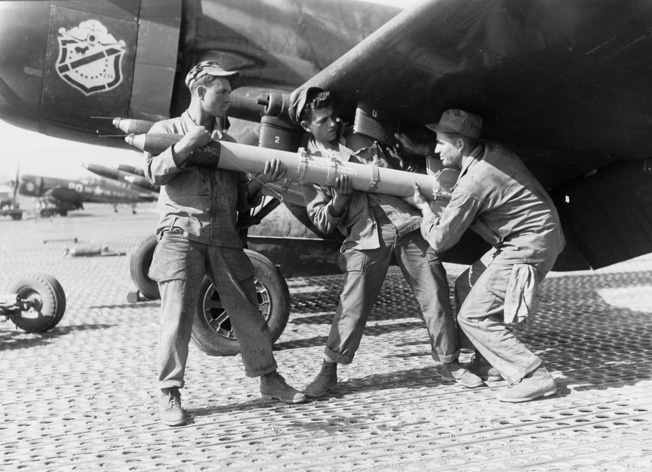
In addition to bombs, the Navy began equipping the Corsair to carry the new high-velocity aircraft rockets that the service had developed, and hard points were installed under the wings that allowed them to carry eight rockets to supplement the firepower of their six .50-caliber machine guns on strafing missions. Corsairs were also equipped to carry napalm as well as high-explosive bombs.
The Navy’s Primary Close Air Support Aircraft
By late 1944, the Department of the Navy had decided to make the Corsair its primary close air support aircraft now that the airplane had been adapted for carrier operations. Previously, Marine squadrons were not assigned to carrier duty nor were Marine pilots carrier qualified due to the increasing need for Navy pilots to staff the squadrons planned for the new fast carriers. With the battle for the Solomons over and with less need for ground-based squadrons in the Central Pacific, many of the Marine fighter squadrons were reassigned to the fleet for carrier duty with the mission of providing close air support for Marines in amphibious operations.
The landing on Iwo Jima was the first to see the Corsair as the primary close air support aircraft. Once again, VMF-124 was first, as the squadron led an attack on the invasion beach by 24 F4Us and an equal number of F6Fs flying from Essex-class carriers with napalm, rockets, and strafing. Although the missions were successful, the Marine squadrons operated over Iwo for only three days. The threat of kamikaze attacks led the Navy to decide to attack air bases on Honshu, and the Marine Corsairs went north with the carriers, leaving the Marines without close air support until Army fighters could be flown in.
Corsairs were also expected to provide close air support for the landings on Okinawa, but the intensity of kamikaze attacks caused Vice Admiral Richmond Kelly Turner, the senior officer in command of the invasion, to order the Corsairs to fly combat air patrols to defend against incoming suicide bombers.
F4U Corsairs Over the Philippines
Corsairs would play a role during the Philippine campaign, as two Marine fighter groups, MAG-12 and MAG-14, made a nearly 2,000-mile journey from the Solomons to take up station onshore on Leyte and Samar. The Corsairs of MAG-12 were brought up to serve with the 308th Bombardment Wing of the Army’s Fifth Air Force in the battle to liberate the Philippines. Although the initial plan had called for the air role in the Philippines to be an all-Army show, events and military politicking on the part of senior Marine officers under Army General Douglas MacArthur’s command led to the introduction of Marine squadrons.
The first Corsairs arrived at Tacloban in early December and immediately went into combat under Army control. The Marines flew with Army P-38s and P-40s on interception and ground attack missions as they fought to deprive the Japanese of the ability to reinforce their forces on Leyte. The aviators not only had to contend with enemy opposition, they also had to be wary of trigger-happy sailors. One Corsair pilot, Lieutenant R.M. Robinson, was shot down by a PT boat and then rescued by the same boat that shot him down!
In spite of enemy opposition that cost the group nine pilots and 34 airplanes, MAG-12 Corsairs accounted for more than 40 Japanese planes and sank seven destroyers, nine freighters, and three troop transports in less than a month. At least 11 other Japanese ships had been damaged. MAG-14 also came up from the Solomons and began operating from Samar in early January 1945. By the time they arrived, the Leyte campaign was winding down, and the war in the Philippines was entering a new phase. MAG-14 Corsairs joined MAG-12 in strikes on targets in the southern Philippines.
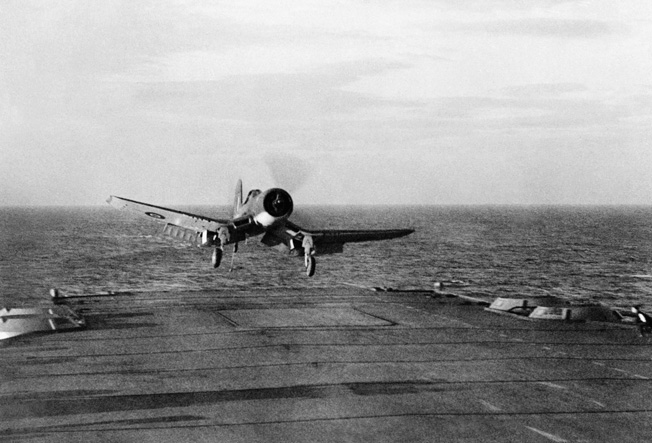
One of the MAG-14 pilots was Ken Walsh, now a captain. The Marine pilots had developed techniques for attacking ships at very low altitude, a tactic they perhaps adopted after the successes of Army light and medium bombers in New Guinea. On February 23, 1945, a flight of Corsairs sank a submarine that they spotted on the surface off Cebu. The four pilots failed to sink either of two subs sighted during their initial attack, but after running out of bombs they returned to their base to rearm. The four Corsairs then dropped down for a wave-top skip-bombing attack with 1,000-pound bombs and sent one of the submarines to the bottom. It was believed to be the first submarine sinking by Corsairs.
Although Marine aircraft were initially prevented from carrying out their new role of close air support of ground troops in the Philippines, by February 1945 Corsairs and Marine SBD dive-bombers were heavily engaged in support of Army ground units. Far East Air Forces commander General George C. Kenney had been less than enthusiastic about close air support because he was afraid that ground troops would come to rely on it to seize their objectives and thus lose the aggressiveness necessary for ground combat. Many of the close air support missions were flown in support of indigenous guerrilla units on Mindanao and in northern Luzon. Corsairs and other Marine aircraft were able to provide firepower that helped the guerrilla units overcome their lack of heavy weapons.
Combatting Kamikazes
The Corsair had originally been designed to defend the fleet, and its finest hour as an interceptor was during the Battle of Okinawa when F4Us provided the first line of defense against almost 1,000 Japanese kamikazes that were launched against the fleet from airfields on Kyushu and Formosa. Considerably faster than the F6F Hellcat and with superior climb performance, the Corsair was more suited to the task of intercepting the incoming Japanese formations before they reached the fleet.
An oft-repeated popular myth is that the F2G version of the Corsair was designed in response to kamikaze attacks, but this is untrue. The F2G was in development before the Japanese adopted kamikaze attacks and was expected to serve as an interceptor against conventional air attack. Only a handful of F2Gs were produced, and the order was cancelled as the end of the war drew near.
The Corsair’s first encounter with kamikazes did not come off too well, as a formation of nine bomb-carrying Zeros managed to break through the fighter screen over the fleet off of Leyte and attacked the small escort carriers that operated offshore. The most serious damage was to the escort carrier St. Lo, which sank. In response to the attacks, the Navy developed tactics to defend against kamikazes by intercepting and shooting them down as far from the fleet as possible. Commander John S. Thach came up with what he called “the big blue blanket,” an around-the-clock fighter patrol over the fleet. Corsairs and Hellcats would maintain station at sea away from the main fleet and carry out airstrikes on Japanese airfields.
Thanks to Thach’s tactics, the intense kamikaze attacks off Okinawa caused far less damage than they might have. Although almost 1,500 kamikazes were launched from Kyushu and Formosa, only a small fraction actually reached the fleet. They managed to inflict heavy damage among the destroyers and other small ships maintaining picket duty away from the main fleet, but none of the capital ships or carriers were sunk although several sustained hits.
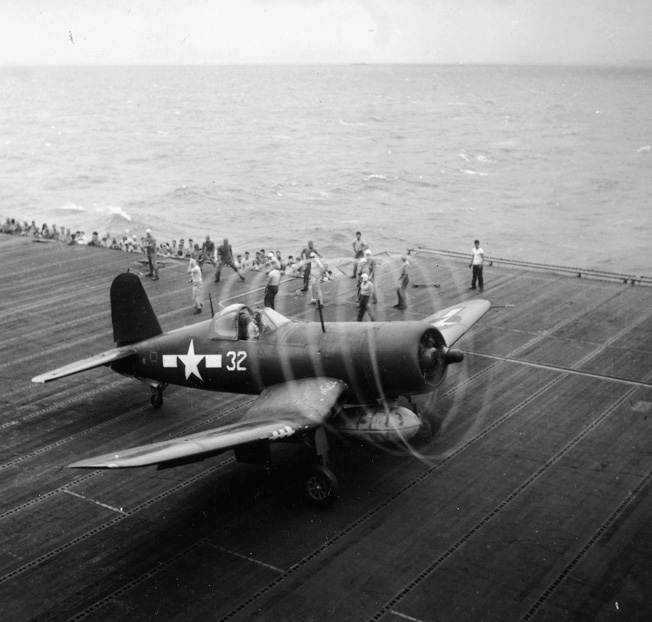
The effectiveness of the Corsair is illustrated by the battle on April 22, 1945, when Corsair pilots from VMF-323 were part of a formation that attacked a force of 80 kamikazes focusing on picket ships north of Okinawa at dusk. VMF-323 pilots alone downed 23 of the attackers in just a few minutes. Three squadron pilots, including the commander, Major George Axtell, shot down five or more airplanes. The battle was fought under low clouds with showers all around. During their combat tour, Axtell and his men were credited with 124.5 Japanese airplanes shot down, most of them kamikazes.
Marine Corsair squadrons at Okinawa operated both from carriers and from Kadena and Yomitan airfields on the island, once they had been secured. Corsair pilots took off and landed on the two airfields even though Japanese troops still held the southern part of the island. The land-based fighters were primarily responsible for the combat air patrols over the ships since they were not hampered by the limitations of carrier operations.
Corsairs were the first choice for kamikaze interceptions due to their higher speeds and climb performance. Marine fighters were credited with 506 of the some 3,000 Japanese aircraft expended during the battle. Roughly half were kamikazes. Navy fighters and antiaircraft accounted for most of the rest. Less than 10 percent of the kamikaze aircraft managed to actually mount attacks.
Other Allied Corsair Operators
In addition to the Corsairs operated by the Navy and Marine Corps, the British Royal Navy and the New Zealand Air Force also took deliveries of new birds straight from the factories. The first Royal Navy Corsairs were delivered in November 1943. Royal Navy pilots were sent to the United States to train in the new airplanes, then were sent to the fleet. Although they were plagued with the same problems as the U.S. Navy in regard to carrier operations, the British squadrons operated off carriers from the beginning.
The demand for Corsairs led United Aircraft to license Brewster Aircraft and Goodyear to build the airplanes, including many of the British airplanes. After the initial delivery of 95, British Corsairs were delivered with eight inches clipped off the wings to allow easier storage aboard carriers.
British Corsairs flew their first combat missions in April 1944 in support of a Royal Navy strike against the German battleship Tirpitz, which was cloistered in a Norwegian fjord. A few days after the Corsair involvement in attacks on the Tirpitz, Royal Navy Corsairs went into operation in the Indian Ocean. The Royal Navy equipped 13 of its squadrons with Corsairs, a total of 225 airplanes. British Corsairs operated off Royal Navy carriers in the Pacific during the final months of the war, participating in air strikes in bypassed areas of the Southwest Pacific as well as Okinawa and Japan itself. Lieutenant Robert Hampton Gray, a Canadian flying with the Royal Navy, was awarded the Victoria Cross for attacking and sinking a Japanese destroyer off Honshu on August 9, 1945.
New Zealand received more than 400 Corsairs, and the first squadron became operational in May 1944 on Espiritu Santo. With Rabaul bypassed, the war was moving north, and the Kiwi Corsair squadrons were assigned primarily to ground-attack missions against isolated Japanese positions on islands that had been bypassed.
The other primary user of the Corsair was France, although the French did not begin operating the Vought fighters until after World War II had come to an end. After receiving a number of former U.S. Marine Corsairs that had fought in Korea, France contracted with Chance-Vought for 94 new planes, and the assembly lines were reopened and production continued from 1952 to 1953. Consequently, the Corsair had the longest production history of any U.S. reciprocating engine fighter.
A Misleading 11 to 1 Kill-Loss Ratio
While the F4U Corsair is sometimes depicted as the finest Allied fighter of the war, its record is actually mixed. U.S. Marine and Navy Corsair pilots were credited with shooting down 2,140 Japanese planes with a kill-loss ratio of 11 to 1, the lowest loss rate of any fighter of the Pacific War. But the statistics are misleading. The air-to-air role of the Corsair was primarily in the Solomons and Rabaul campaigns, and once the war moved farther north, Corsair squadrons saw less opportunity for air-to-air combat and less exposure to attack by Japanese aircraft.
Most of the leading Corsair aces racked up their scores from August 1942 after the invasion of Guadalcanal to January 1944 when the skies over Rabaul were secured. After that, Corsair operations were primarily in the ground-attack role except for the few weeks in December 1944 during the battle for Leyte. Marine Corsair squadrons were heavily involved in defending the fleet against kamikaze attacks, but the suicide pilots were not trained for air-to-air combat.
Other fighter types—particularly Navy and Marine F6Fs and Army P-38s and P-47s—saw considerably more air-to-air combat than the F4Us during the last 18 months of the war. The accident rate for the Corsair was deplorable. Only 189 F4Us were lost in air-to-air combat, while 349 fell to ground fire, but 692 were lost in nonoperational accidents. Operational losses (accidents during combat) claimed 230 of the bent-wing birds.
World War II’s Last American Fighter
The Corsair was the only World War II operational fighter that continued in production after the war ended. While production of Grumman F6Fs ceased, Corsair production continued into the 1950s as F4Us remained in Navy and Marine service, primarily in the ground-attack role. The Navy also used Corsairs in the night-fighter role, and Navy Lieutenant Guy Bordelon achieved ace status by shooting down five enemy planes, making him the only Navy ace of the Korean War as well as the only ace of the war to make all of his kills in a propeller airplane. He was most likely the last propeller ace in history.
One Corsair pilot was credited with bringing down a Japanese plane by chopping off its tail with his propeller. Marine Lieutenant R.R. Klingman was attempting to intercept a twin-engine Japanese bomber at high altitude off Okinawa when his guns iced up due to the extreme cold and would not fire. Not willing to let the enemy plane escape and perhaps dive into the side of a ship, Klingman pulled up behind the bomber and let his propeller eat into its tail.
The tail came off, and the bomber spun to earth out of control. Although he lost five inches of his propeller, Klingman managed to land safely and was awarded the Navy Cross for the mission. It was not the first time a Corsair brought down an enemy plane by direct contact. The first Japanese plane brought down by a Corsair was the result of a midair collision.
F4U Corsairs continued in military service with several countries through the 1950s and 1960s, although the U.S. Navy retired the type after the Korean War. French Corsairs flew in Indochina and Algeria. The last combat use of Corsairs was in 1969 during a conflict between El Salvador and Honduras, both of which operated the type.

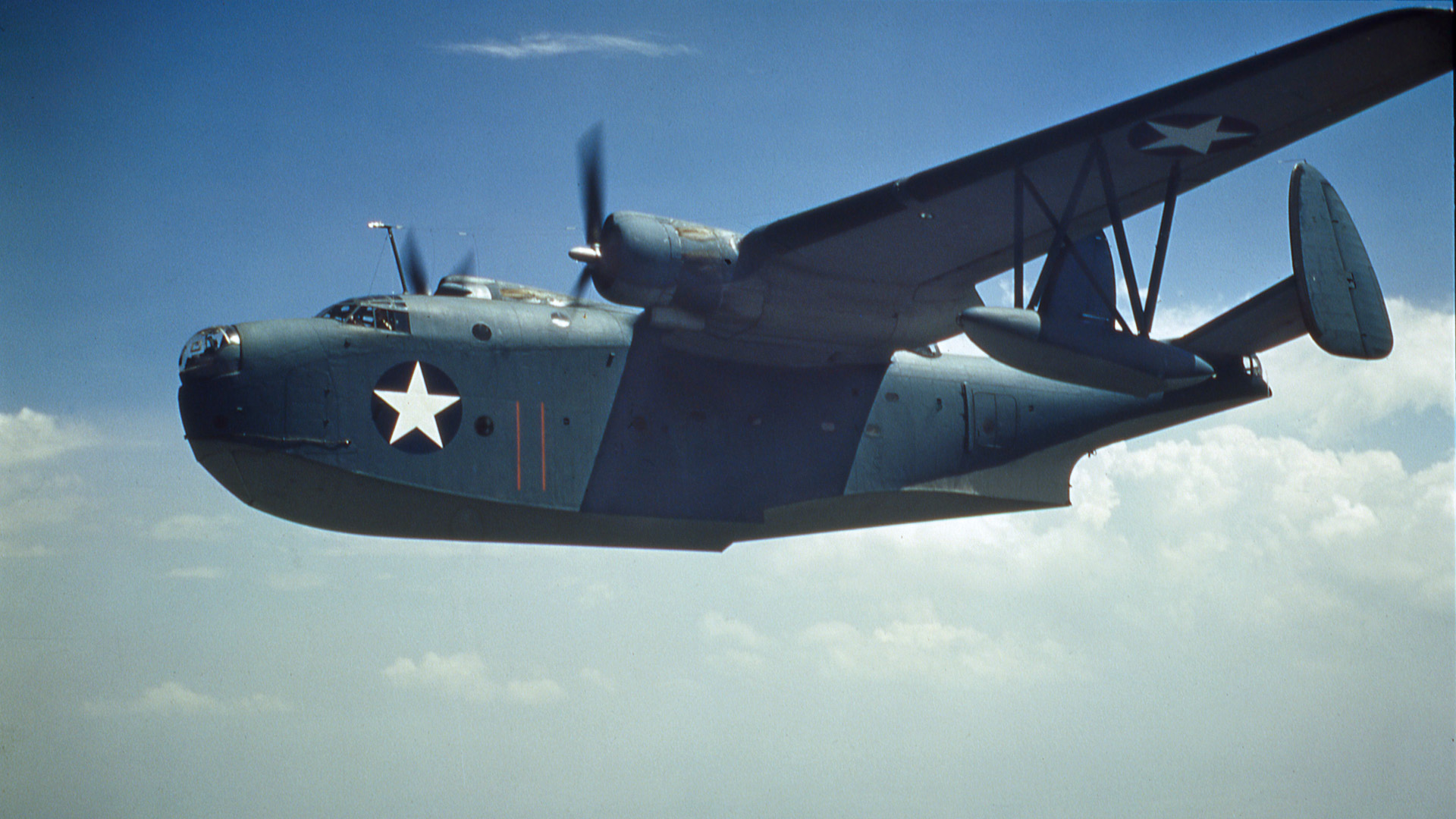
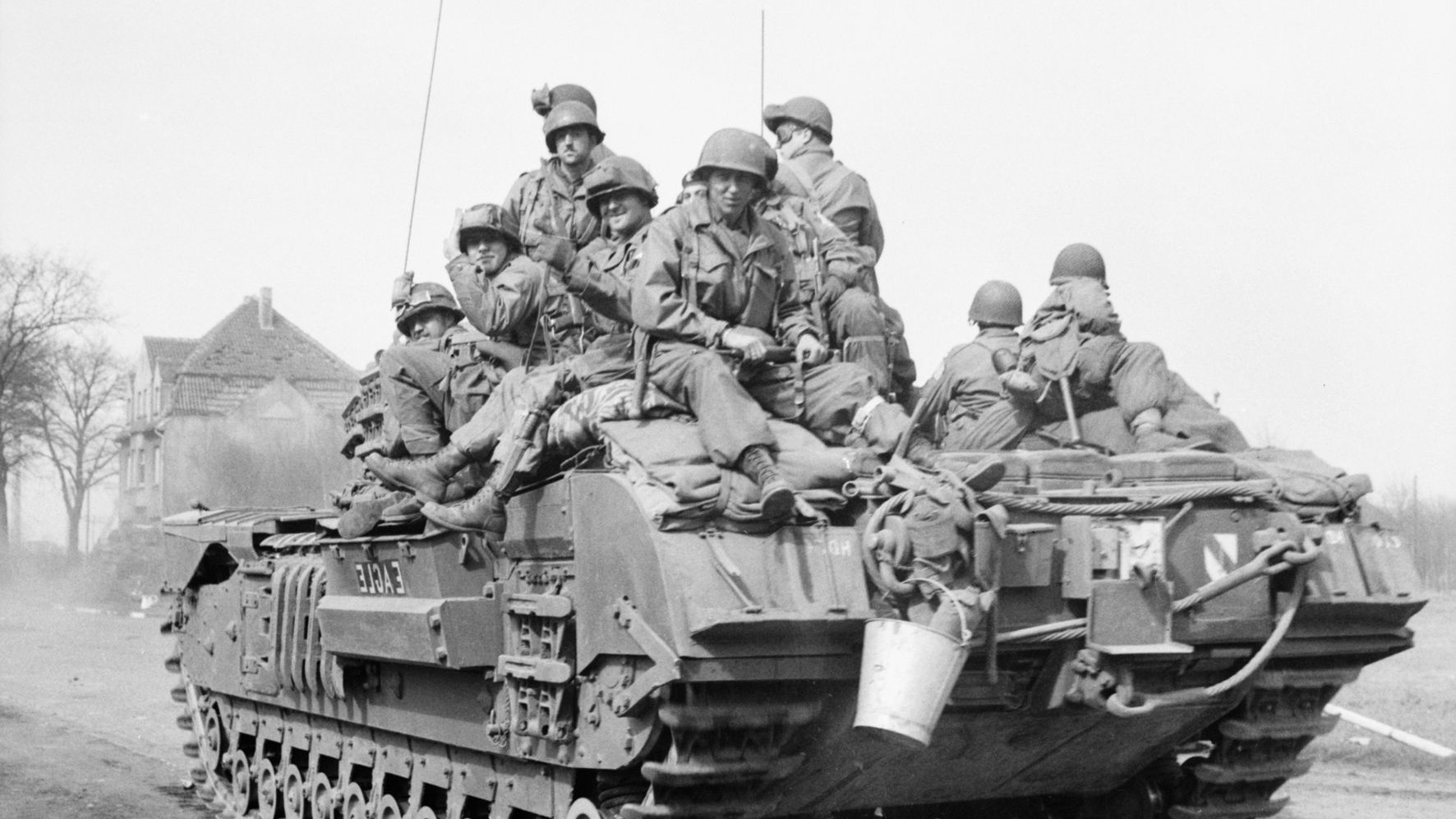
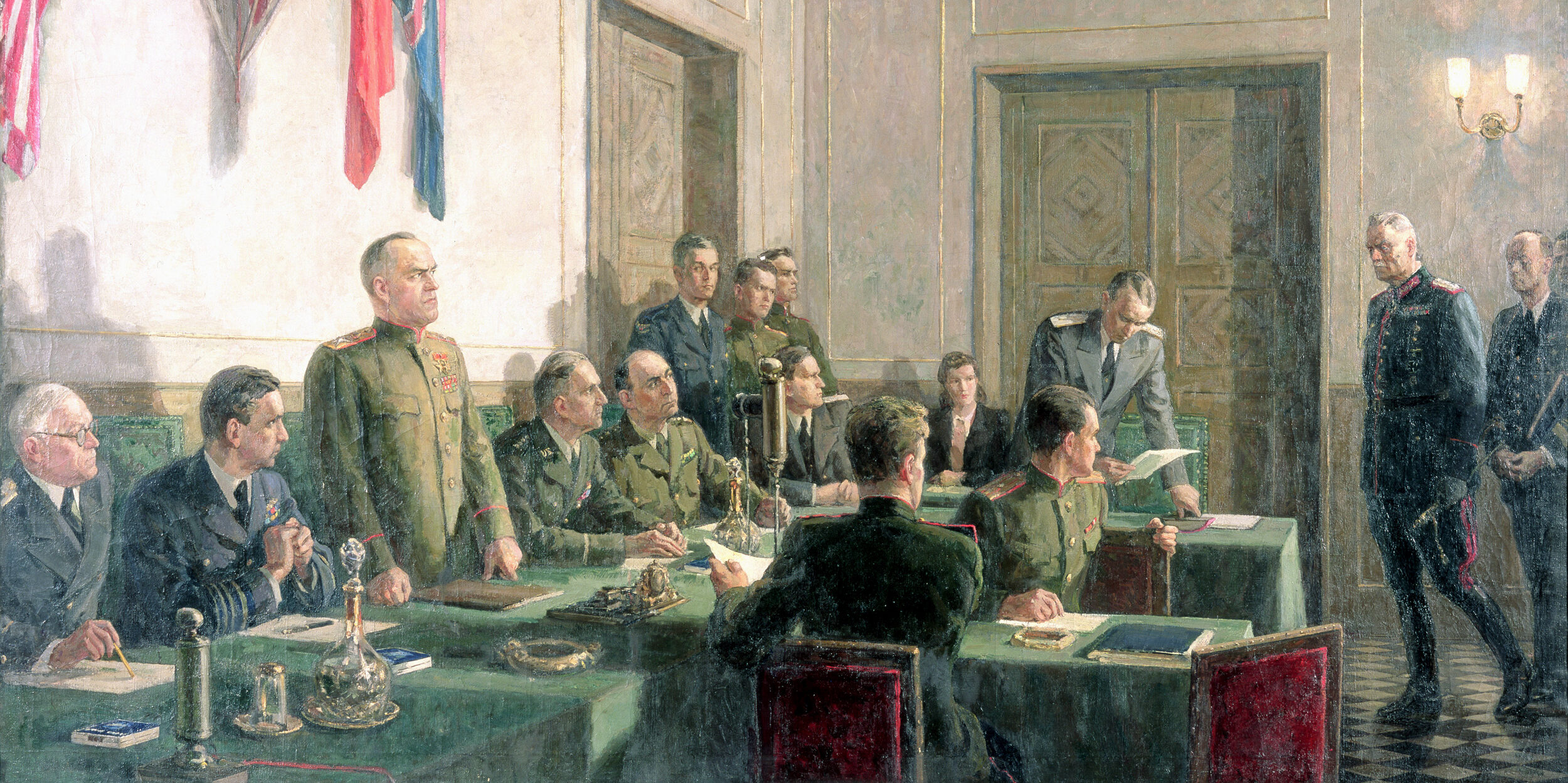
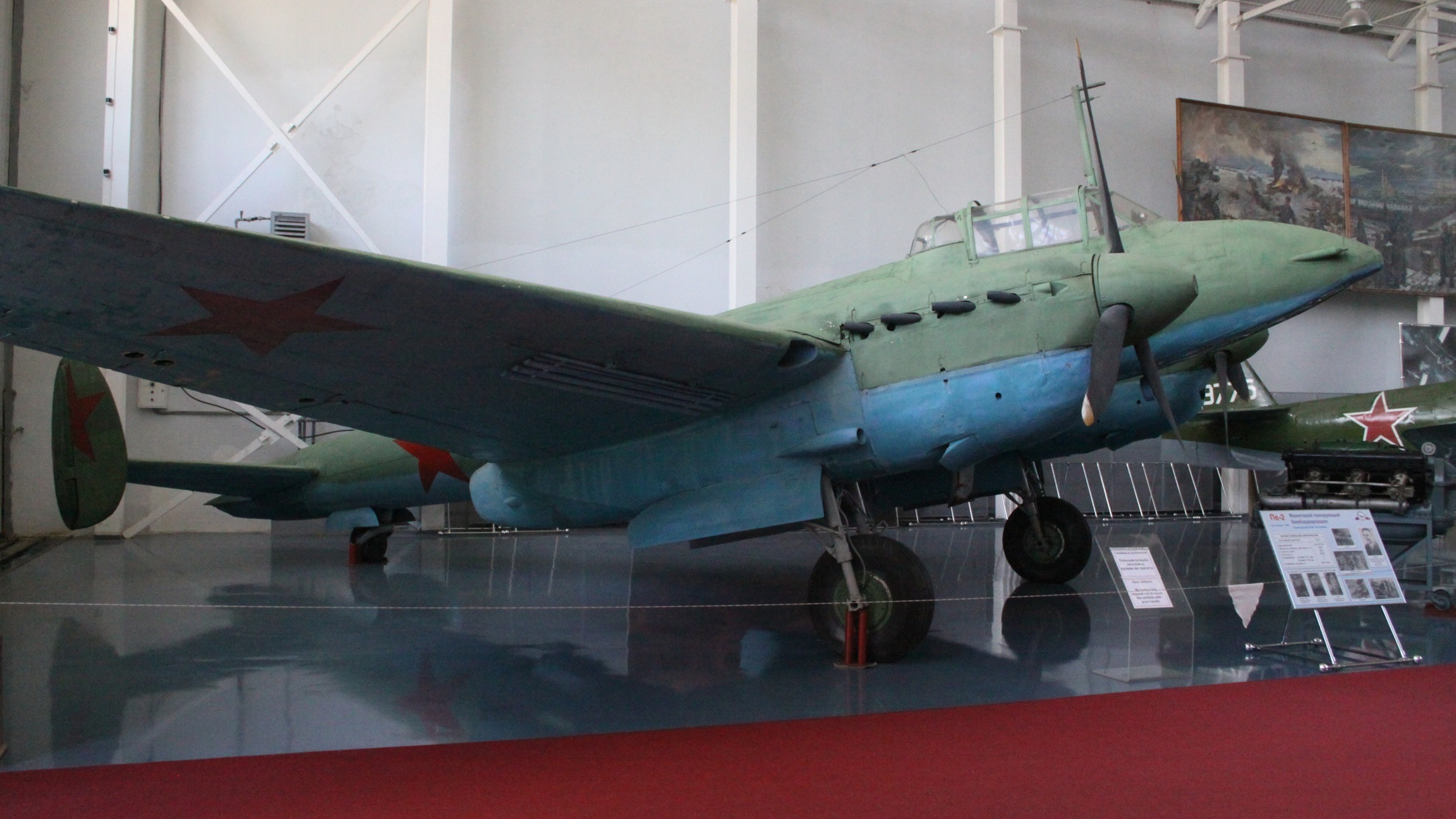
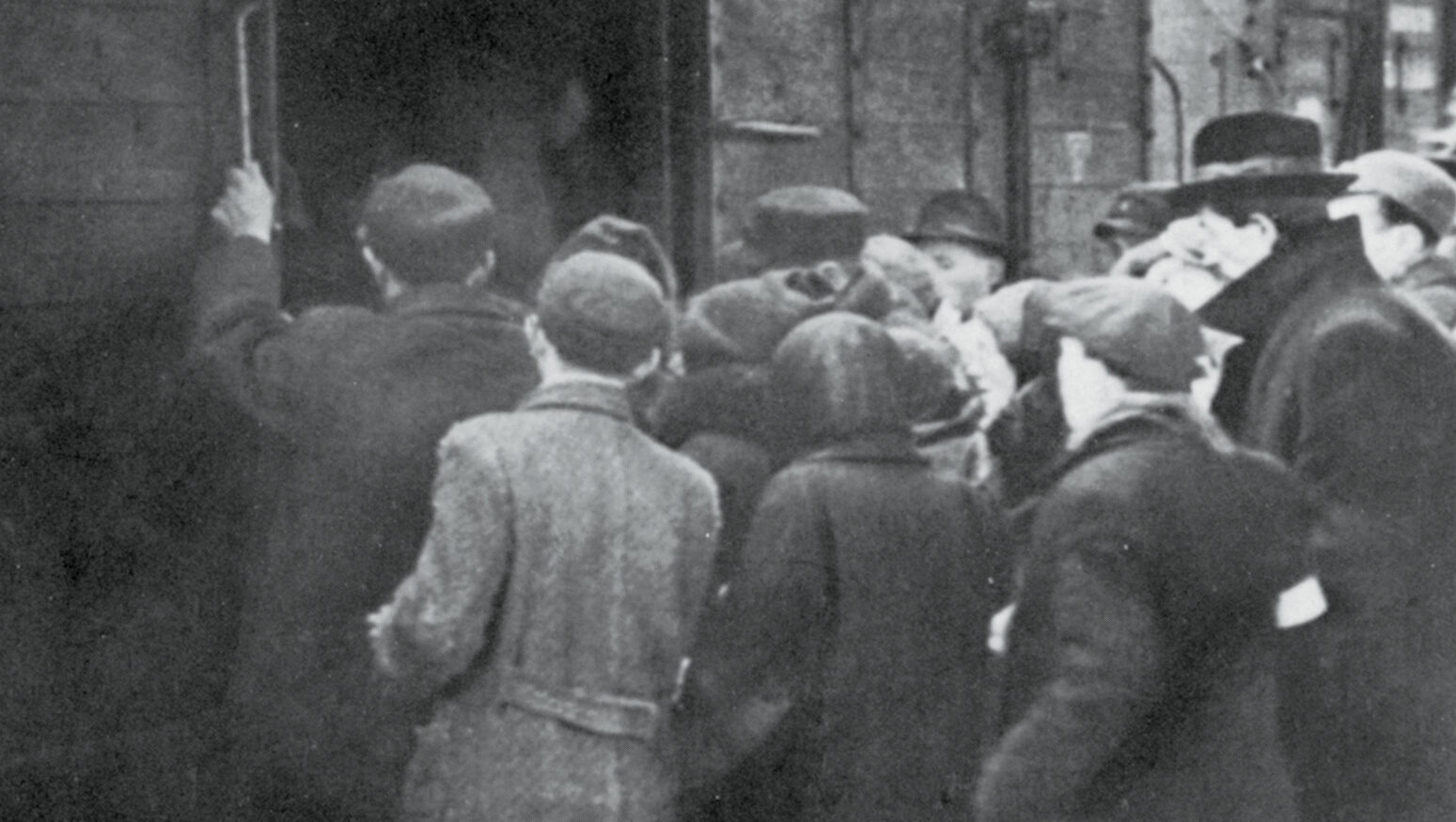
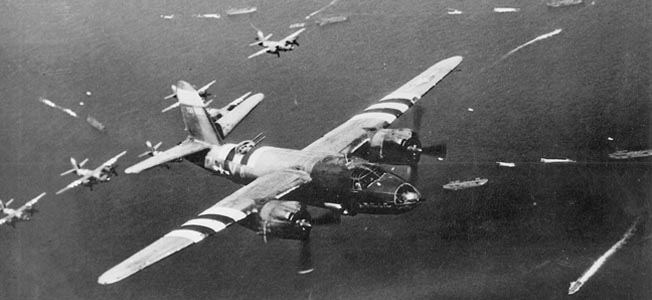
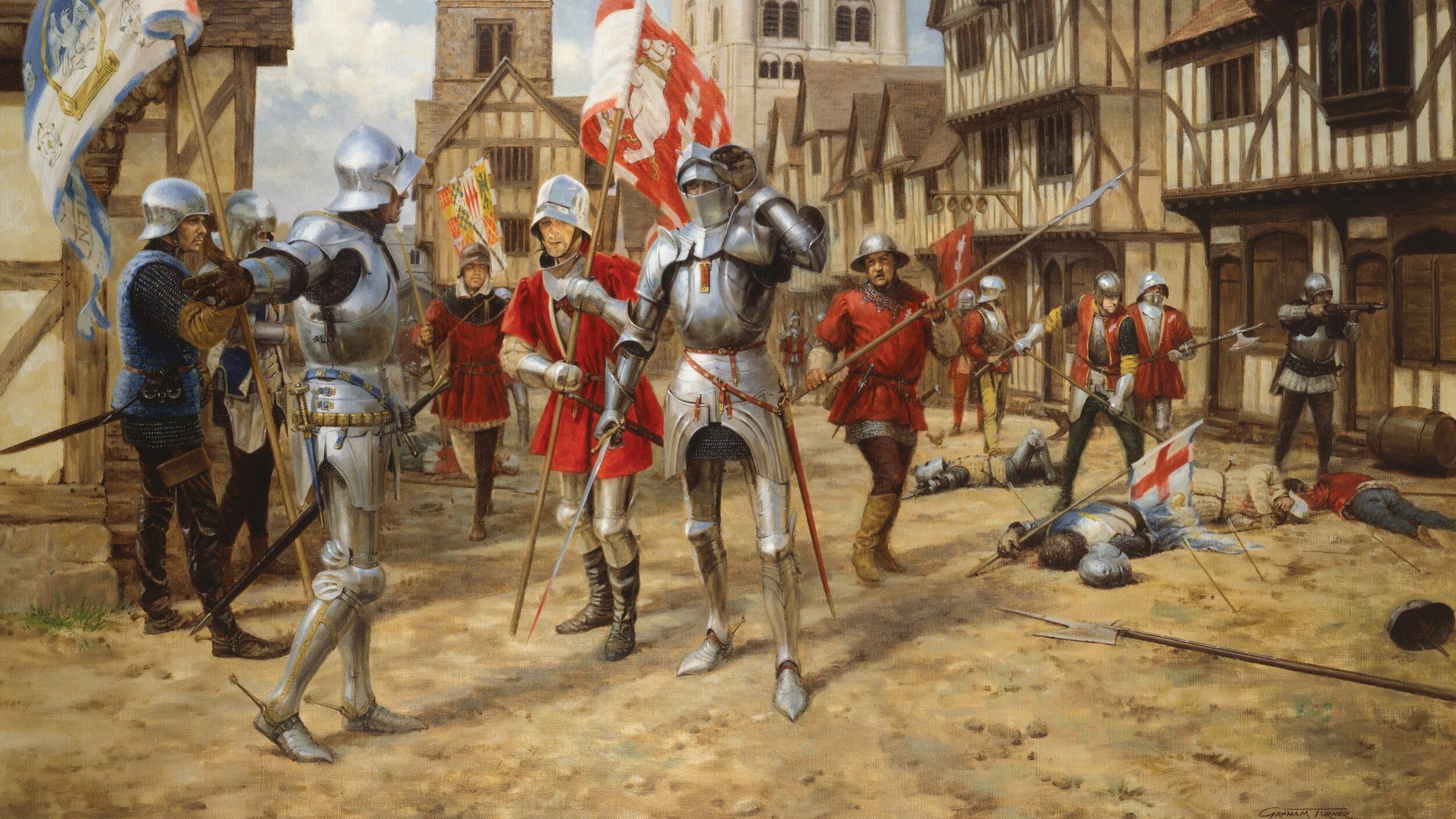
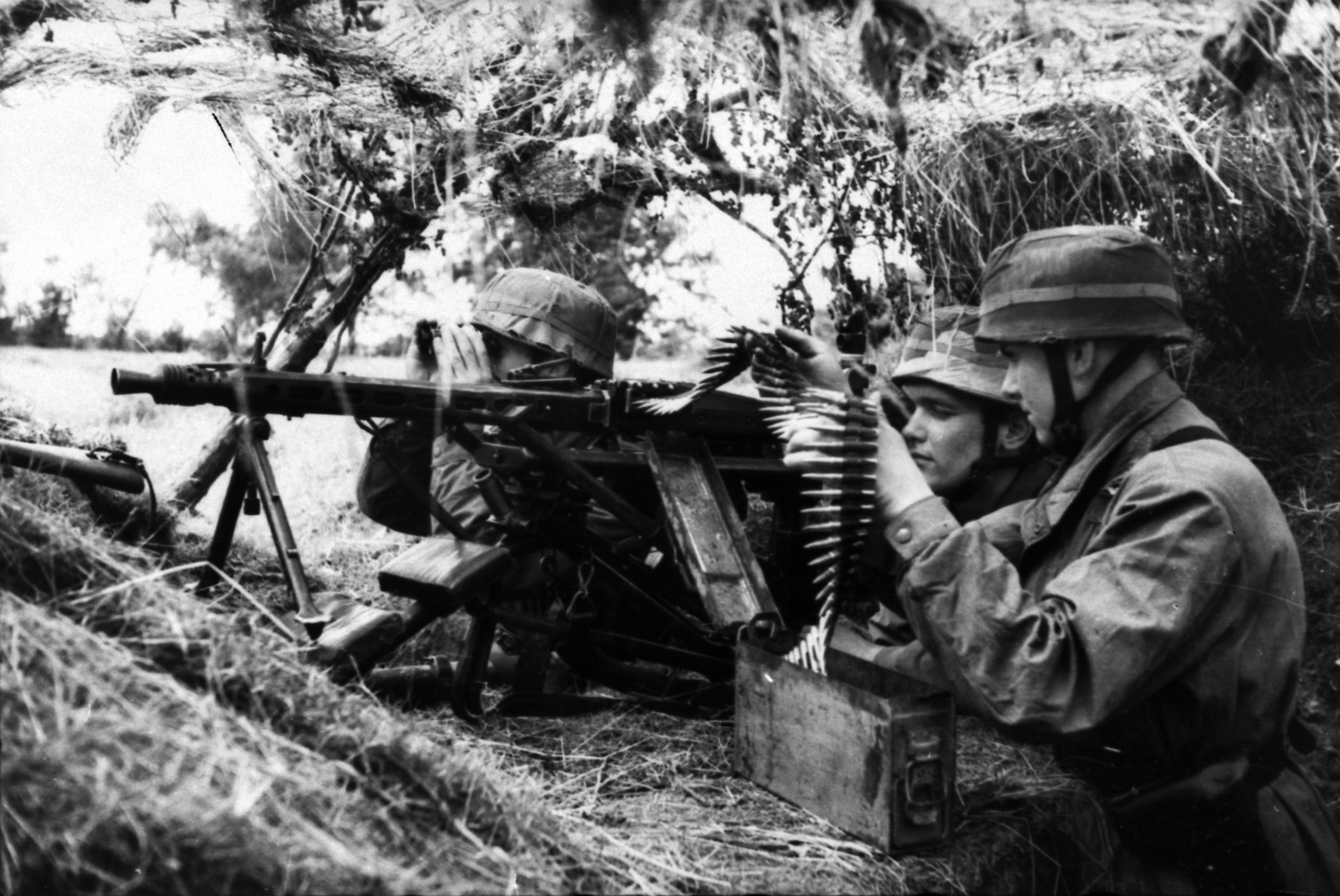
Join The Conversation
Comments
View All Comments